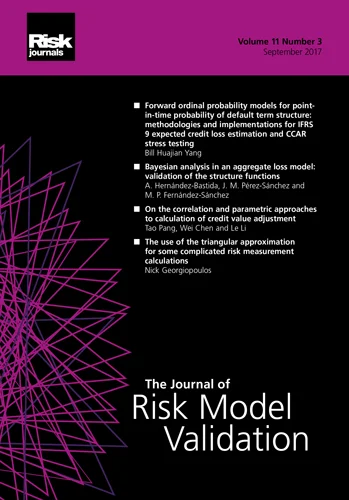Journal of Risk
ISSN:
1465-1211 (print)
1755-2842 (online)
Editor-in-chief: Farid AitSahlia
Volume 25, Number 4 (April 2023)
Editor's Letter
Farid AitSahlia
Warrington College of Business, University of Florida
For nearly three decades now, a variety of risk measures have been advocated, with mixed results. This issue of The Journal of Risk includes a systematic review of the literature on value-at-risk estimation and a theoretical analysis of combining risk measures. These papers are complemented by a balance-sheet evaluation in the presence of jumps and by an empirical study comparing oil and currency exchange markets during the Covid-19 pandemic.
In “Value-at-risk models: a systematic review of the literature”, the first paper in this issue, Reem Shayya, Maria Teresa Sorrosal-Forradellas and Antonio Terceño present a study to find the most frequently used models in the literature and to verify whether their popularity has changed since the 2007–9 financial crisis. They find autoregressive models, extreme value theory and simulation to be the most commonly used models. They also note that the autoregressive conditional heteroscedasticity (ARCH) and generalized autoregressive conditional heteroscedasticity (GARCH) models have been the most popular since the crisis, but they find no significant difference in the percentage of articles on the other models they study.
Next, in “A theory for combinations of risk measures”, Marcelo Brutti Righi addresses the issue of combining different risk measures, each tailored to a specific risk, with the ultimate goal of dealing with a single optimization problem with no restrictive assumptions. Righi proposes a framework that combines a potentially uncountable set of risk measures but that still preserves their distinctive qualities and captures the interplay between the choice of risk measures and the functional form of their combination. A general characterization for the convex and coherent cases is also presented.
In the issue’s third paper, “A dynamic program under Lévy processes for valuing corporate securities”, Hatem Ben-Ameur, Rim Chérif and Bruno N. Rémillard apply dynamic programming to both finite-activity and infinite-activity Lévy models in a structural approach to valuing corporate securities. Through numerical and empirical illustrations using Gaussian, double exponential and variance-gamma jump models, the authors show that they are able to identify significant credit spreads over short maturities.
Rounding out this issue is “The relationship between crude oil futures and exchange rates in the context of the Covid-19 shock: a tale of two markets” by Ziliang Yu, Yanan Liu, Huiting Mang and Xiaomeng Liu. Here the authors study high-frequency intraday return and volatility transmission between crude oil futures prices and currency exchange rates during the 2020 Covid-19 pandemic. Specifically, they compared the renminbi-denominated crude oil futures market in China (Shanghai International Energy Exchange) and US dollar-denominated Brent prices in the United Kingdom. Yu et al found significant disparities, both before and after the China and UK lockdowns, in return linkages between crude oil markets and currency exchange, but negligible differences regarding volatility transmission patterns. The authors investigated utilizing offshore instead of onshore exchange rates, and looked at return and volatility spillovers during the 2022 Covid-19 shock that emerged in Shanghai.
Papers in this issue
Value-at-risk models: a systematic review of the literature
The authors conduct a systematic literature review of value-at-risk models to determine which models are most often used and whether any change in model popularity occurred after the 2007-9 financial crisis.
A theory for combinations of risk measures
This paper investigates combinations of risk measures under no restrictive assumption on the set of alternatives, obtaining results regarding the preservation of properties and acceptance sets for these combinations of risk measures.
A dynamic program under Lévy processes for valuing corporate securities
The authors design and solve an extended structural model that accommodates arbitrary Lévy dynamics for the underlying firm’s asset value, realistic debt payment schedules, multiple seniority classes and various intangible assets.
The relationship between crude oil futures and exchange rates in the context of the Covid-19 shock: a tale of two markets
The authors investigate the high-frequency intraday return and volatility transmission between crude oil futures prices and exchange rates during the 2020 Covid-19 pandemic in the Brent and INE markets.








